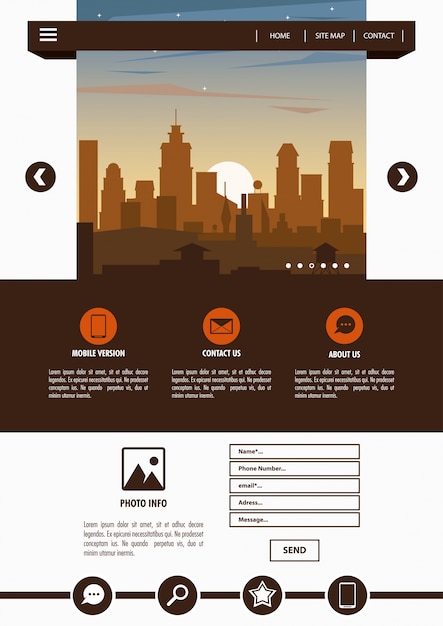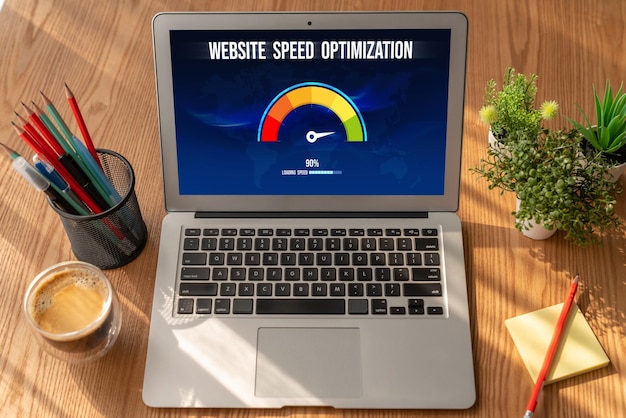Build a Website in Under an Hour: WordPress Guide (2025)

Building a website in under an hour is achievable with WordPress in 2025 by using pre-designed themes, drag-and-drop builders, and streamlined content creation, allowing beginners to quickly establish an online presence.
Want to launch your dream website quickly? Learn how to build a website in under an hour: a beginner’s guide to WordPress in 2025.
The Evolving Landscape of Website Creation
Creating a website used to be a complex and time-consuming task, often requiring extensive coding knowledge and design skills. However, the rise of user-friendly platforms like WordPress has democratized the process, making it accessible to individuals and small businesses with limited technical expertise. In 2025, building a website can be surprisingly quick and easy, thanks to advancements in technology and the availability of powerful tools.
The traditional approach to web development involved writing HTML, CSS, and JavaScript from scratch, which could take days or even weeks to complete a basic website. Today, WordPress offers a streamlined alternative, allowing users to create visually appealing and functional websites in a fraction of the time. This shift has empowered entrepreneurs, bloggers, and creatives to establish their online presence without the steep learning curve.
The Role of WordPress in Modern Web Design
WordPress has become the dominant force in the web design world, powering a significant percentage of all websites on the internet. Its popularity stems from its open-source nature, its vast ecosystem of plugins and themes, and its user-friendly interface. The platform’s flexibility allows users to create everything from simple blogs to complex e-commerce stores.
The key advantage of WordPress is its ability to separate content from design. This means that users can focus on creating compelling content without getting bogged down in the technical aspects of web development. With a wide range of customizable themes and drag-and-drop page builders, anyone can create a professional-looking website without writing a single line of code.
- Accessibility: WordPress makes website creation accessible to individuals with varying levels of technical skills.
- Flexibility: The platform’s vast ecosystem of plugins and themes allows for customization and expansion.
- Cost-Effectiveness: WordPress is free to use, and many themes and plugins are available at no cost.
- Community Support: A large and active community provides support and resources for WordPress users.
In conclusion, the evolution of website creation has been marked by a shift from complex coding to user-friendly platforms like WordPress. This has empowered individuals and small businesses to establish their online presence quickly and easily. As technology continues to advance, building a website in under an hour will become even more commonplace.
Essential Tools and Resources for Rapid Website Building
To build a website quickly using WordPress, it’s essential to have the right tools and resources at your disposal. These tools can significantly streamline the process, allowing you to focus on creating compelling content and establishing your brand’s online presence. From pre-designed themes to drag-and-drop page builders, several options can help you create a professional-looking website in under an hour.
Choosing the right tools is crucial for maximizing efficiency and achieving your desired results. Consider your specific needs and technical skills when selecting themes, plugins, and hosting providers. With the right combination of resources, you can create a website that meets your goals without spending hours on coding and design.

Selecting a Fast and Lightweight Theme
One of the most important decisions you’ll make is choosing a WordPress theme. A well-designed theme not only provides a visually appealing framework for your website but also affects its performance and speed. Opt for a lightweight theme that is optimized for fast loading times and minimal bloat.
Several themes are specifically designed for speed and simplicity, offering a clean and modern aesthetic without sacrificing functionality. Look for themes that prioritize performance and offer customization options that align with your brand’s identity. Avoid themes with excessive features or complex layouts that can slow down your website.
Leveraging Drag-and-Drop Page Builders
Drag-and-drop page builders have revolutionized the way websites are created, allowing users to design custom layouts without writing code. These tools provide a visual interface where you can drag and drop elements like text, images, and buttons onto your pages. This approach significantly reduces the time and effort required to create a professional-looking website.
Popular page builders like Elementor, Beaver Builder, and Divi offer a wide range of pre-designed templates and modules that you can customize to suit your needs. These tools also provide real-time previews, allowing you to see how your website will look on different devices as you build it.
- Elementor: A popular page builder with a user-friendly interface and a wide range of features.
- Beaver Builder: A lightweight and flexible page builder with a focus on performance.
- Divi: A powerful page builder with a vast library of pre-designed templates.
- Gutenberg: The default WordPress block editor, offering a simple and intuitive way to create content.
In summary, essential tools and resources like fast themes and drag-and-drop page builders are critical for rapid website building. These components streamline the design process, enabling users to create visually appealing and functional websites efficiently. By carefully selecting and utilizing these tools, you can build a professional website in under an hour.
Step-by-Step Guide to Building Your Website
Now that you have the necessary tools and resources, let’s dive into the step-by-step guide to building your website in under an hour. This process involves setting up your WordPress installation, selecting a theme, customizing your website’s design, and adding content. By following these steps, you can create a fully functional website that represents your brand and achieves your online goals.
The key to building a website quickly is to plan and prioritize. Before you start, outline your website’s structure and content, and gather any necessary images or text. This will help you stay focused and avoid time-consuming detours during the building process.
Setting Up Your WordPress Installation
The first step is to set up your WordPress installation. This involves choosing a hosting provider, registering a domain name, and installing WordPress on your server. Many hosting providers offer one-click WordPress installations, making the process quick and easy.
Once WordPress is installed, you’ll need to access the WordPress dashboard, which is the control panel for managing your website. From here, you can install themes, plugins, and customize your website’s settings.
Customizing Your Website’s Design
With WordPress installed, the next step is to customize your website’s design. This involves selecting a theme that aligns with your brand’s identity and customizing it to suit your needs. You can use the WordPress theme customizer to change colors, fonts, and layouts.
If you’re using a drag-and-drop page builder, you can create custom page layouts by dragging and dropping elements onto your pages. Experiment with different layouts and designs to find what works best for your content.
- Choose a Theme: Select a lightweight and customizable WordPress theme.
- Customize the Design: Use the WordPress theme customizer or a page builder to adjust colors, fonts, and layouts.
- Create Custom Pages: Design custom page layouts using a drag-and-drop page builder.
- Optimize for Mobile: Ensure your website is responsive and looks good on all devices.
In short, by setting up WordPress properly and customizing your site’s design, you lay the foundation for a successful online presence. These steps are crucial for ensuring your site is visually appealing and functional from the start.
Optimizing Your Website for Speed and Performance
Optimizing your website for speed and performance is crucial for providing a positive user experience and improving your search engine rankings. A fast-loading website not only keeps visitors engaged but also signals to Google that your website is high-quality. Several strategies can help you optimize your website for speed and performance, including optimizing images, caching, and minifying code.
Slow loading times can lead to high bounce rates and lost conversions. Visitors are more likely to abandon a website that takes too long to load, which can negatively impact your business. By optimizing your website for speed, you can improve user engagement and drive more traffic to your site.
Optimizing Images for Web Use
Images can significantly impact your website’s loading times. Large image files can slow down your website, especially for visitors with slow internet connections. Optimizing images involves compressing them without sacrificing quality, reducing their file size.
Several tools and plugins can help you optimize images for web use. These tools automatically compress images when you upload them to your website, ensuring that they are optimized for fast loading times.
Implementing Caching Strategies
Caching involves storing static versions of your website’s pages, so they can be served to visitors more quickly. When a visitor accesses a cached page, the server doesn’t have to generate it from scratch, which can significantly reduce loading times.
Several caching plugins are available for WordPress, such as WP Super Cache and W3 Total Cache. These plugins allow you to enable caching with just a few clicks, improving your website’s speed and performance.

- Compress Images: Optimize images to reduce file size without sacrificing quality.
- Enable Caching: Implement caching strategies to store static versions of your website’s pages.
- Minify Code: Remove unnecessary characters from your website’s code to reduce file size.
- Use a CDN: Distribute your website’s content across multiple servers to improve loading times for visitors around the world.
In summary, optimizing your website for speed and performance is essential for providing a positive user experience and improving search engine rankings. Speed improvements enhance user engagement and drive more traffic to your site.
Adding Essential Plugins to Enhance Functionality
Plugins are essential for enhancing the functionality of your WordPress website. They allow you to add features like contact forms, social media integration, and e-commerce capabilities without writing code. With thousands of plugins available, it’s important to choose the right ones for your specific needs.
Plugins can significantly improve your website’s user experience and help you achieve your online goals. However, it’s important to use plugins sparingly and choose high-quality ones that are well-maintained. Too many plugins can slow down your website and create security vulnerabilities.
Installing a Contact Form Plugin
A contact form is essential for allowing visitors to get in touch with you. Contact form plugins allow you to create custom contact forms with various fields, such as name, email, and message. These plugins also provide spam protection to prevent unwanted submissions.
Popular contact form plugins include Contact Form 7, WPForms, and Gravity Forms. These plugins offer a wide range of features and customization options.
Implementing SEO Plugins
SEO plugins help you optimize your website for search engines like Google. These plugins provide tools for managing meta descriptions, generating sitemaps, and analyzing your website’s SEO performance. They can also help you identify keywords and optimize your content for search.
Popular SEO plugins include Yoast SEO, Rank Math, and All in One SEO Pack. These plugins offer a comprehensive set of features for improving your website’s search engine rankings.
- Contact Form Plugin: Allow visitors to get in touch with you.
- SEO Plugin: Optimize your website for search engines.
- Security Plugin: Protect your website from security threats.
- Social Media Plugin: Integrate your website with social media platforms.
In short, adding essential plugins greatly improves your WordPress website’s functionality, allowing features like contact forms, SEO tools, and security enhancements. These plugins elevate the user experience and improve your site’s discoverability.
Maintaining and Updating Your Website for Long-Term Success
Maintaining and updating your website is crucial for long-term success. Regular updates not only improve your website’s security and performance but also ensure that it remains compatible with the latest WordPress versions and plugins. A well-maintained website provides a positive user experience and helps you achieve your online goals.
Neglecting your website can lead to security vulnerabilities, slow loading times, and compatibility issues. Regular maintenance is essential for preventing these problems and ensuring that your website remains a valuable asset for your business.
Regularly Updating WordPress and Plugins
One of the most important maintenance tasks is regularly updating WordPress and your plugins. These updates often include security patches, bug fixes, and new features. Keeping your website up-to-date ensures that it is protected from the latest security threats and that you are taking advantage of the latest features.
WordPress provides automatic update notifications, making it easy to stay informed about available updates. You can also enable automatic updates for plugins, so they are updated automatically in the background.
Backing Up Your Website Regularly
Backing up your website regularly is essential for protecting your data in case of a disaster. Backups allow you to restore your website to a previous state if something goes wrong, such as a security breach or a server failure.
Several backup plugins are available for WordPress, such as UpdraftPlus and BackupBuddy. These plugins allow you to schedule automatic backups and store them in a secure location.
- Update WordPress: Keep WordPress and your plugins up-to-date.
- Backup Your Website: Regularly back up your website to protect your data.
- Monitor Security: Monitor your website for security threats and vulnerabilities.
- Optimize Performance: Regularly optimize your website for speed and performance.
In summary, maintaining and updating your website provides long-term success through security improvements, performance enhancements, and compatibility with the latest technologies. Regular maintenance is vital for preventing potential problems and keeping your website effective.
| Key Concept | Brief Description |
|---|---|
| 🚀 Fast Setup | Use one-click WordPress installation. |
| 🎨 Theme Choice | Select a lightweight, customizable theme. |
| 🔧 Key Plugins | Install SEO, security, and contact form plugins. |
| ⚡ Performance | Optimize images and enable caching for speed. |
Frequently Asked Questions
▼
Yes, with the right tools and a clear plan, building a basic website in under an hour is definitely achievable, especially using WordPress and pre-designed themes.
▼
Essential plugins include an SEO plugin like Yoast, a security plugin like Wordfence, and a contact form plugin such as Contact Form 7 to manage communications.
▼
Mobile optimization is extremely important as more users access the internet via mobile devices. Ensure your theme is responsive to provide a good mobile experience.
▼
No coding experience is needed! WordPress is designed for beginners. Use drag-and-drop page builders to design your site visually, without needing to write any code.
▼
It’s best to back up your website regularly, ideally daily or weekly, depending on how frequently you update your content. Use a backup plugin to automate this process.
Conclusion
Building a website in under an hour with WordPress in 2025 is entirely feasible with the right strategy and tools. By choosing a fast theme, leveraging drag-and-drop builders, optimizing images, and implementing essential plugins, you can create a professional-looking website quickly and efficiently. Remember to regularly maintain and update your website to ensure long-term success and a positive user experience.